Copyright 2020 - 2021 irantour.tours all right reserved
Designed by Behsazanhost
The similarities between Persepolis of Achaemenid and Isfahan of the Safavid era
The similarities between Persepolis of Achaemenid and Isfahan of the Safavid era
The Persepolis building was built around 520 BC by the order of Darius the Great (486-522 BC), one of the greatest and most powerful historical and national figures in Iran, and his descendants added huge buildings to each of them. Some parts of this exquisite monument have been resisted for 2,500 years in the face of natural disasters, human injuries, and atrocities. The city of Isfahan in the Safavid era began with the order of Shah Abbas Kabir (1750-1050), one of the greatest and most powerful historical and national figures of Iran. Also, After him, prestigious buildings were added to this city. Isfahan's structures of the Safavid era have resisted various events for nearly 400 years and are now mentioned as another group of the clearest historical evidence of Iran. The monuments of these periods, as one of the most valuable documents of Iran's history, architecture, and art, attract thousands of tourists from all over the world every year. Persepolis is more than 2100 years older than Isfahan, but, despite this time gap, there are special historical and national ties between them.
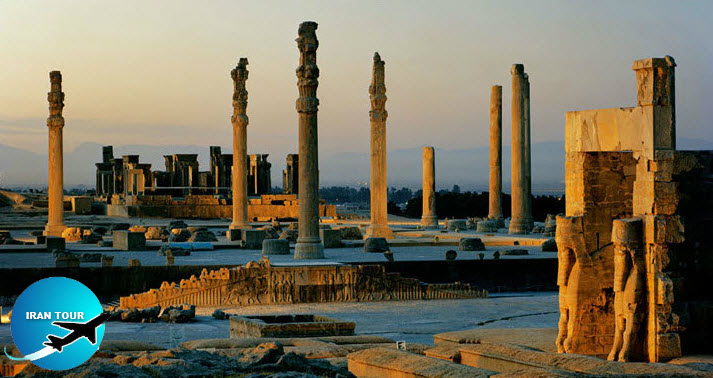 |
These links are categorized into three sections.
1- Persepolis and its founders.
2- Isfahan Safavid era and its founders.
3- Historical links between them.
 |
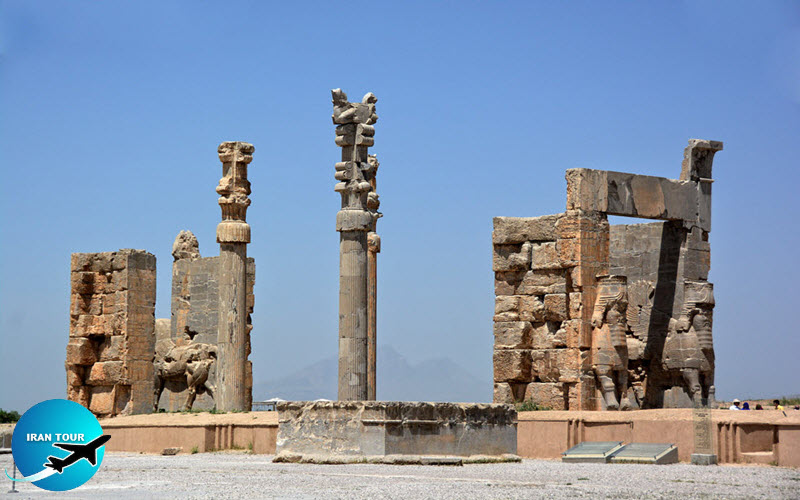 |
A- Persepolis and its founders
The Achaemenid Empire (550 BC - 230 BC)
The greatest Iranian Empire or Achaemenid Empire starts about 550 B.C. The great Cyrus was the founder of it was a descendant of the Achaemenid family. He selected Susa, the ancient capital of Ilam, as his capital. This government is known as the cradle of Asian civilization in the ancient world. He captured different lands and expanded his Empire rapidly. He was a young and energetic leader and was an intelligent & generous commander and strategist and was able to seize Lydia, Babylon, and other countries swiftly and announce himself king of Anshan and Ilam. His prism of human rights was inscribed on a cylindrical tablet in Babylon in the year 538 BC. He showed this charter to all the tribes and proved to them his respect for all nations and religions.
The Great Darius, the third Achaemenid King, and the most famous king of the Achaemenian dynasty extended their borders from India at East to the Adriatic Sea at West and from Caucasus mountains, Caspian Sea, and Transoxiana at the north, to Egypt, Ethiopia, and Sea of Oman. Darius was the great architect of the Achaemenid Empire. He was a real architect of the Empire who established the "Imperial Guard or Perpetual Guard" with 10 thousand immortal soldiers who were ready to fight and die for the king.
One of the most important features of the Achaemenid civilization was using other nations' capabilities thus Iranian art flourished rapidly and reached its peak during the Achaemenid Period. By building new strategic roads, establishing a very swift courier service throughout the empire, introducing gold and silver coins for trade, applying a suitable legal code, and introducing a comprehensive taxation system Darius succeeded to set up an advanced civilization. According to historians, the later Achaemenid kings turned to luxury and neglected their army and the strength of the Empire. This weakness caused the young Alexander to attack Iran and exhaust the Achaemenid rule. in 330 B.C. and defeat and destroy the Empire which had governed the country and nearly the world of that time for 230 years.
One of the most magnificent Achaemenid buildings was built in Persepolis. The building was built on a huge platform with an area of approximately 450 x 300 meters and enclosed by a fence, and the important parts of it that have been known so far are as follows:
-Gate of All Lands (Nations)
- Apadana Palace
- Tachara Palace
- The Harem or Seraglio
- The Museum
- Hall of Hundred Columns
- Achaemenid tombs
-Army Street
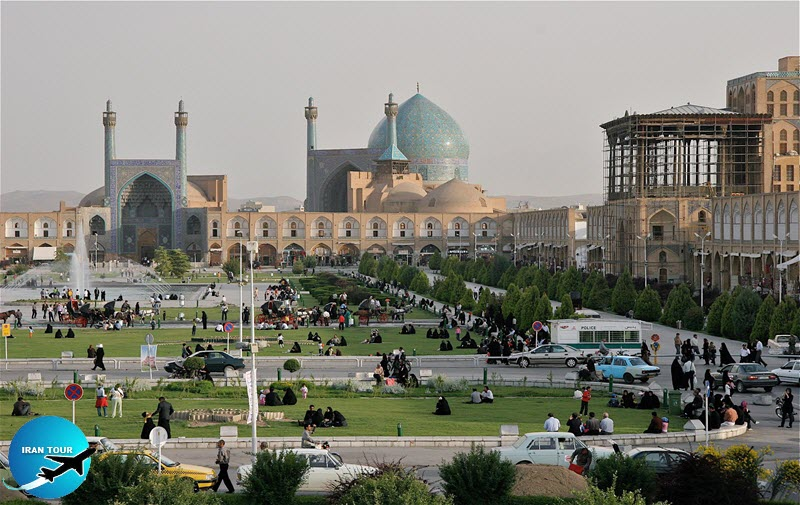 |
B: Isfahan Safavid era and its founders
The Safavid government or Safavid Dynasty (1501 - 1736), which is to be seen as a new system in the Iranian political and religious system, has led to Iran's independence from the Shiite religion as an official religion and a centralized government. In addition, the creation of the new dynasty encouraged Iranian artists to display their culture, architecture, and fine arts. In the meantime, exchanges have developed with the beginning of diplomatic relations with Europe and neighboring countries.
Shah Abbas and his successors built many caravansaries in the country to promote trade and made the roads safer. The small Iranian dynasties that emerged after the Arab conquest did not normally benefit from national unity, and a dynasty often governed several separate territories at the same time. Shah Esmaeel founded the Safavid dynasty in 1500 AD and spent most of his time fighting hostile tribes in eastern and western Iran. Shah Abbas the Great set up a very strong army and equipped it with modern weapons. This allowed him to defeat all Iranian enemies, including the Ottoman Turks, and to expel the Portuguese aggressors from the Persian Gulf. In addition to his military adventures, Shah Abbas built magnificent places, mosques, and bridges and spent his entire life embellishing Isfahan, the capital of the Safavid Empire. In the end, the Safavid dynasty weakened and deteriorated by resorting to luxury and court intrigue. Afghans, neighbors of Iran in the east, have taken advantage of the weakness and shyness of the last Safavid king, Shah Sultan Hussein. They attacked the Iranian capital and destroyed the Safavid dynasty.
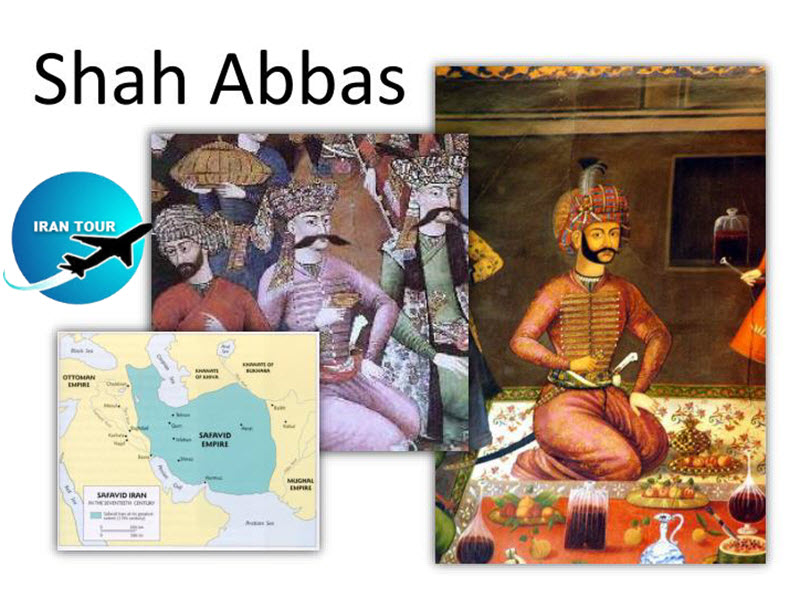 |
Shah Abbas I and the Golden Age of Esfahan's History
The history of Esfahan cannot be separated from the name of Shah Abbas the Great, the ruler who chose it as a capital in 1598 and spent forty-two years of his life toward its beautification and eminence. Brought up in Herat, the great cultural and intellectual center of Iran in the 16th century, since childhood Shah Abbas had been influenced by its magnificent architecture, painting, and calligraphy. The young prince showed astounding precocity as a connoisseur of the arts. When he was seven years old, an emissary from the royal court arrived in Herat accompanied by his favorite painter, Habibollah of Saveh. Abbas appreciated the artist's work and unceremoniously appropriated him from his master.
In 1587, Shah Abbas was crowned king. He started his career by eliminating all those who had made (and could unmake) him shah. In 1591, he appointed as his grand vizier a gifted aristocrat, Hatim Beik Ordubadi, a determined man who accomplished a series of reforms that helped to increase the Shah's control over the entire country. In his late twenties, Shah Abbas was near the height of his power. His “revolution from above” preceded that of Louis XIV, but was at least as far-reaching.
Shah Abbas was famed as a very energetic person. He loved hunting and often busied himself in the royal stables. He was a skilled craftsman, making scimitars, bridles, and saddles for his horses, weaving fabrics, and distilling flower water with his own hands. Sometimes he gutted the fish or skinned the game he had killed and cooked it himself. Though almost illiterate, he was an able conversationalist with a thirst for useful knowledge. In a discussion, he was quick to get the point and was always ready to skewer an opponent's remark with a sharp and well-aimed thrust. He was eager to learn about foreign lands and never missed an opportunity to cross-examine visitors from Europe about conditions in their home countries. Like his contemporary Akbar in India, Shah Abbas enjoyed discussing religion with Christians, with whom he was very tolerant and protective, and found it amusing to see his own clerics struggle with the missioners' arguments. Like many oriental monarchs, he enjoyed going about among his subjects, and often he strolled the streets incognito. Another very notable feature of Shah Abbas was his extreme superstitiousness. He never took up any Esfahan under Shah Abbas's Successors The period after Shah Abbas's death, except for a short interlude during the reign of his grandson Shah Abbas II was marked by a gradual decline. However, this decline was felt much less in Esfahan than in other parts of Iran. By the end of the Safavid period, Esfahan remained one of the most magnificent cities in the world. According to a description that appears in Chardin's travel account, Esfahan contained 162 mosques, 48 madrasahs, 1,802 commercial buildings, and 283 bathhouses. Most of these buildings no longer survive, but those that do remain constitute some of the city's finest monuments.
The most important artistic masterpieces created in Isfahan during the Safavid period are:
- Chehel Sotoon Palace
- Hasht Behesht Palace
- Imam Mosque(Jame Abbassi Mosque)
- Sheikh Lotfollah Mosque
- Qeisarie Grand Bazaar
- Ali Ghapoo Palace
- The Bridges over Zayande Rood - Naghsh e Jahan Square
and more...
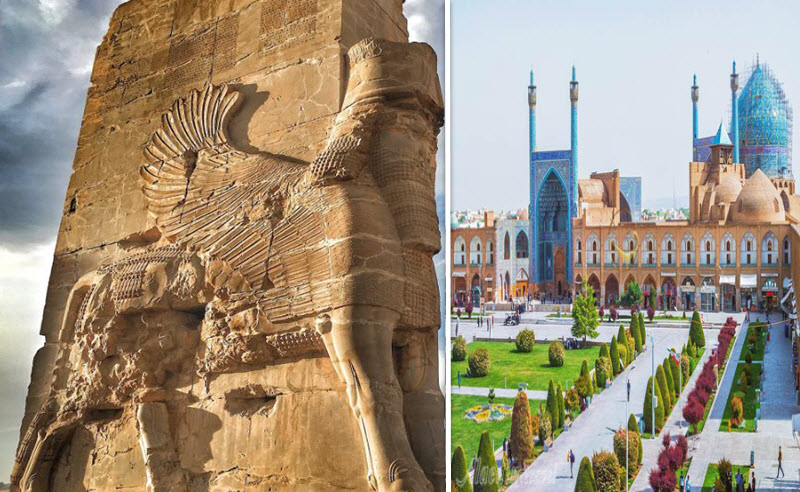 |
C- Historical links between Persepolis Achaemenid and Isfahan Safavid era
1- Antiquity
When Persepolis was built in Persia and was the seat of the Achaemenid emperors, Isfahan also existed in the Northern part of Pars and was one of the Achaemenid imperial residences. These two cities were inhabited simultaneously and were almost on the focus of the Achaemenid king's attention.
Persepolis was destroyed by Alexander's forces and was unable to regain its former prosperity, but Isfahan continued its ups and downs and saved his gained credit during the Safavid era and earlier. Isfahan is still alive.
These two cities are like two brothers, one of whom reached the peak of glory and died. But the other one after more than two thousand years is at the highest point of growth yet.
2- Location
These two cities are located beside the fertile plains Persepolis is located in the west of Rahmat mountain and east of Marvdasht, and Isfahan in the east of Zagros mountains and next to Isfahan plain.
3- Founders
Each of the two cities has been built or developed by one of the greatest national dynasties of Iran. They have been very patriotic and tried hard to develop the country. They used all the local and non-native artists and craftsmen for this purpose.
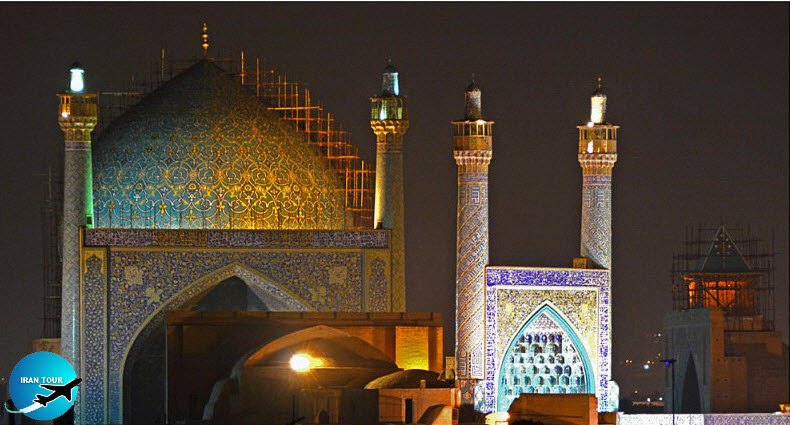 |
4- The purpose of creation and development
Persepolis was one of the Achaemenid capitals and Isfahan was one of the Safavid capitals.
The two cities had not only a political function but also a religious one. Especially Persepolis, which according to some historians was not a political capital at all.
"It's a common western theory that Persepolis seems to have been originally a magnificent palace built to describe political power and royal pleasure," said Pope the American Iranologist.
Persepolis was, in fact, a sacred national shrine dedicated to a special purpose: in order to establish a stable base for the celebrations of spring or Nowruz. But about the religious section of the Safavid era, the Safavids strongly supported the Shiite religion and this city had both political center and religious functions. Both cities welcomed the different guests, representatives of nations, or ambassadors, who had come as a visitor or gifted presenters.
5-Natural Design
Gardens have had special importance in the architecture and design of the cities of Persepolis and Isfahan. Unfortunately, in the case of Persepolis, the location of the gardens is not clear, but this can be inferred from the writings of some historians. Also, the numerous motifs of flowers, plants, and pine trees that have been carved in the bas-reliefs confirm it. There is a lot of evidence about the gardens of Isfahan and the location of the gardens is very clear. The most important of these gardens was created on Chahar Bagh Street by the order of Shah Abbas.
6- Historical monuments
The structures and buildings of Persepolis are similar to the buildings of Isfahan in the Safavid era and have historical links as follows:
 |
| Tachra Palace |
A-plan:
1- Building architecture
The structures and buildings of Persepolis are similar to the buildings of Isfahan in the Safavid era and in other words, have historical links:
In terms of the plan:
1. The buildings of Persepolis were built on a huge platform, and each of them could have a separate platform, such as the Apadana Hall. This platform has been used in some buildings of Isfahan such as Chehel Soton Hall.
2- In the buildings of Persepolis, the rectangular courtyard and the porch and the square halls have been highly regarded, such as the courtyard and the porch of the private palace of Darius the 100 columns Hall and the square halls of the palace with three gates,...
Also, the courtyard and porch and square halls are mostly used in Isfahan buildings, and sometimes all these elements combine together simultaneously such as the Shah Mosque of Isfahan which has one main courtyard and two side courtyards, four porches, and three square halls. Sheikh Lotfollah Mosque Square Hall is another luxurious example of Safavid-era square hall. The existing difference is related to the covering of the building, which means that the roofs of the Achaemenid halls and porches were flat, it was necessary to use columns to support this type of roof, but in the Safavid era, when the dome or Barrel vault was used for covering, there was no need to columns. Also in the Safavid era, the hypostyle with a flat roof has been considered and a clear example of this is the large porch of Ali Qapo High Palace.
3. In the important buildings of Persepolis, there was usually a gate in which the entrance to the palace was allowed through it, therefore it was of special importance and respect, such as the gate of Xerxes.
This gate or entrance was also present in the palaces of Isfahan in the Safavid era, such as the high entrance of Ali Qapoo in Isfahan, which has given this title to all parts of the palace due to its respect and importance.
4- In all Persepolis buildings, columned halls have been common and mostly were huge and wide, such as Apadana and Column of 100 columns' Hall. This type of hall is also common in Isfahan during the Safavid era and the best example is the forty columns Palace.
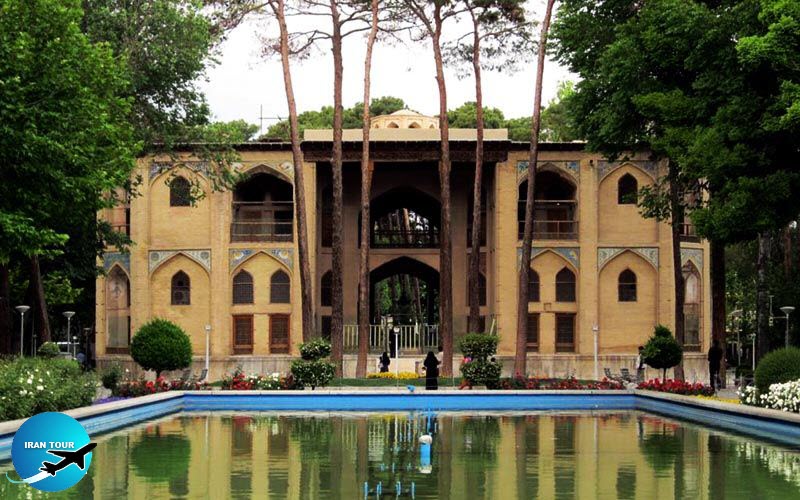 |
| Hasht Behesht Palace |
B: Form
1-There is a difference in building coverage
The roof of most Achaemenid buildings, including Persepolis, was flat and was placed on stone or wooden pillars, but in the Safavid era, most of the buildings, such as the corbel dome and domical vault or Barrel vault, were used.
2- Many stone and wooden columns have been used in Persepolis buildings. In the Safavid buildings, columns have been used, but these columns are mostly wooden and bricky, such as the columns of the high porch of Ali Qapoo and the columns of forty columns and brick columns of some mosques in Isfahan.
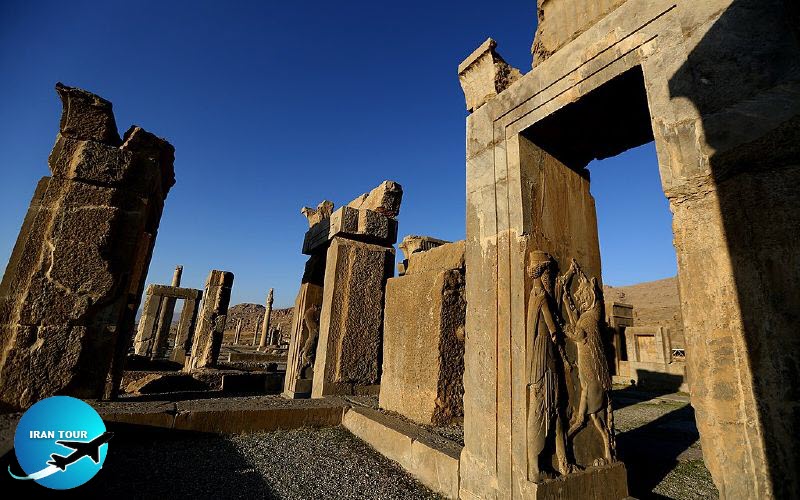 |
C: Materials
1- In Persepolis, most structures are made of stone and other materials were in less attention. But In the Safavid period, the buildings have made of brick, but occasionally stone was used, such as thin and long stone pieces that were installed on the walls and rafters of the Shah Mosque.
2- In some cases, Adobe (raw clay) has been used in the Persepolis and Isfahan buildings of the Safavid era.
3- Some buildings of Persepolis like the columns were made of wood, such as the parts related to the treasury, and on the roof, and the wooden frames and some parts of Apadana Hall. In Isfahan'sSafavid era, columns and wooden frames have been used, and our clear examples are the high porch of Qapo and forty columns.
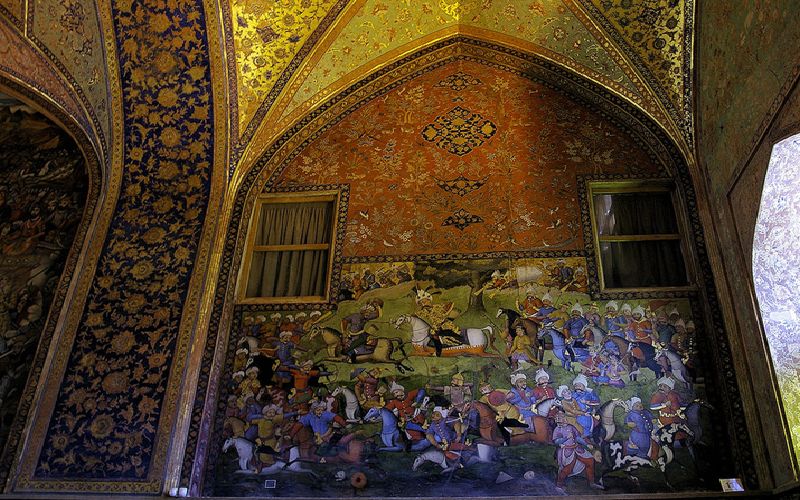 |
D: Decorations
1- In Persepolis, most of the carvings are bas-relief. But in the Safavid period, the decorations are of tiles, plastering, and mirror work, but some decorations on the stone were also common, such as carved stones of Shah Mosque and the base of some columns of the palace, and the garden of forty columns.
2- In columns decorating Persepolis and Isfahan, fluted stones were common, such as the Apadana columns and forty columns.
3- The entrance door of some important buildings of Persepolis and Isfahan are decorated with Mogharnas decoration. But these decorations were executed on the stone in Persepolis, and in Isfahan with tiles and mosaics. such as the entrances of the Column Dam Hall and the Three Gates Palace of Persepolis and Sheikh Lotfollah Mosque and Shah Mosque of Isfahan.
4- In most decorations of Persepolis, scenes of historical events are carved such as visiting the king, reception, victories, wars, etc. have been involved.
This type of historical scene has been shown in the decoration of Isfahan's buildings too, but Persepolis scenes, are reliefs and Isfahan scenes, such as the head in Caesarea and forty columns and Hasht Behesht Palace, are paintings.
5- In Persepolis motifs, by showing the clothes and the delegation of representatives of different nations, an anthropological issue is raised, which is also raised in Safavid paintings.
- Details
- Category: IRAN Blog